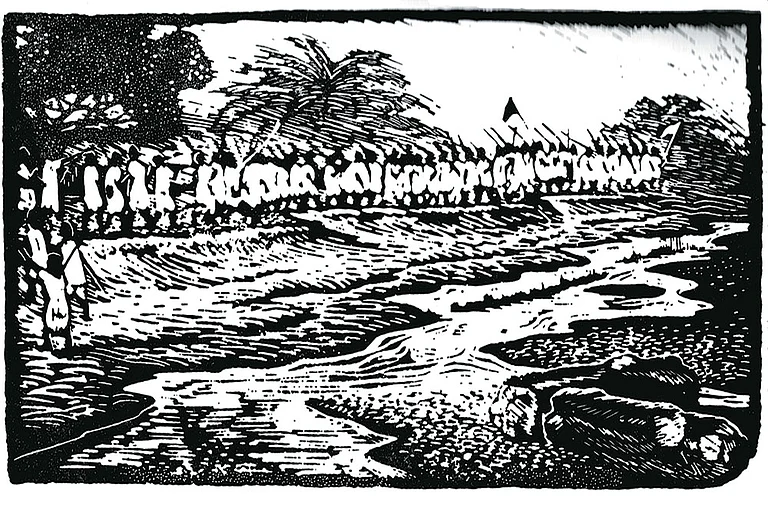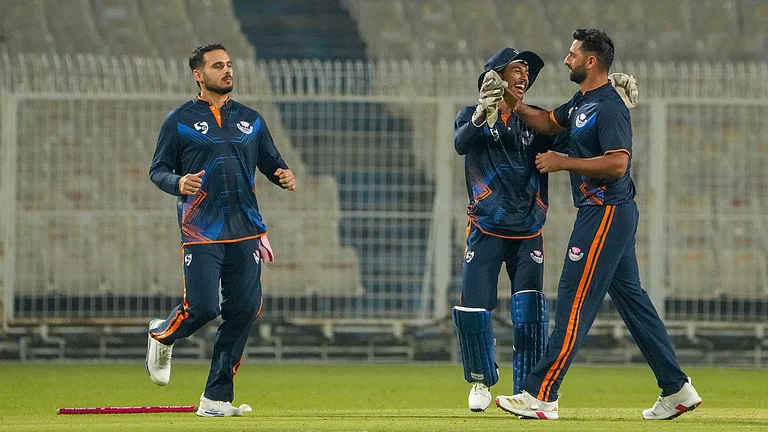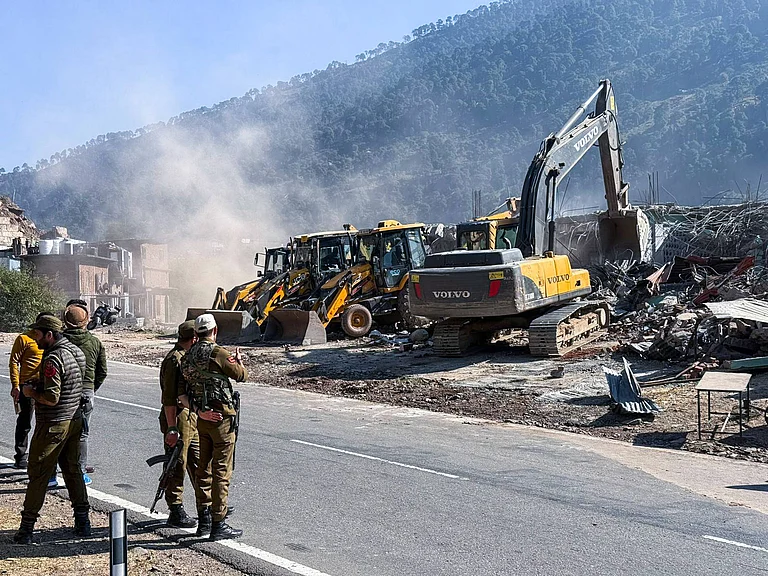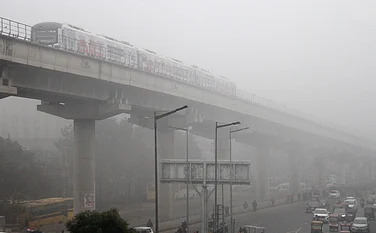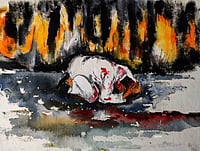After "necessary investigations" of the speeches on Kashmir made by Arundhati Roy, Shuddhabrata Sengupta, Varavara Rao, Syed Ali Shah Geelani, SAR Geelani and Sheikh Showkat Hussain at a seminar, "Azadi-the Only Way" on October 21 in Delhi on October 21, 2010, the Delhi Police had earlier, "acting in accordance with the letter and spirit of the law,” decided not to file any case against the individuals concerned.
Not satisfied with this turn of events — "the state must show tolerance and forbearance," the home minister P.Chidambaram had said — someone called Sushil Pandit, who, as it turns out, happens to be the advertising campaign manager of Mr Arun Jaitley of the BJP, filed a complaint before a Delhi magistrate who demanded that police should file a First Information Report (FIR)
An FIR was lodged on November 29 under sections 124A (sedition), 153A (promoting enmity between classes), 153B (imputations, assertions prejudicial to national integration), 504 (insult intended to provoke breach of peace) and 505 (false statement, rumour circulated with intent to cause mutiny or offence against public peace).
The complainants insist that they also hope to approach the court for registration of charges under Section 121 (waging war or attempting to wage war against country) of IPC as well.
What was Arundhati Roy's crime? What had she said? We reproduce below the transcript of the speech
SAR GEELANI: now I request Arundhati Roy to come and speak.
AR: If anybody has any shoes to throw, please throw them now ..
Some people in the audience: we’re cultured…etc..etc
AR: Good, I’m glad. I’m glad to hear that. Though being cultured is not necessarily a good thing. But anyway..
[interruption from some people in the audience (inaudible in the video)]
SAR GEELANI: please will you talk afterwards. Now prove that you are cultured.
AR: About a week or 10 days ago, I was in Ranchi where there was a Peoples’ Tribunal against Operation Green Hunt— which is the Indian state’s war against the poorest people in this country—and at that tribunal, just as I was leaving, a TV journalist stuck a mic in my face and very aggressively said “Madam, is Kashmir an integral part of India or not? Is Kashmir an integral part of India or not?” about five times.
So I said, look, Kashmir has never been an integral part of India. However aggressively and however often you want to ask me that. Even the Indian government has accepted, in the UN that it’s not an integral part of India. So why are we trying to change that narrative now? See, in 1947, we were told that India became a sovereign nation and a sovereign democracy, but if you look at what the Indian state did from midnight of 1947 onwards, that colonized country, that country that became a country because of the imagination of its colonizer—the British drew the map of India in 1899— so that country became a colonizing power the moment it became independent, and the Indian state has militarily intervened in Manipur, in Nagaland, in Mizoram.. (Someone’s phone rings here).. in Mizoram, in Kashmir, in Telangana, during the Naxalbari uprising, in Punjab, in Hyderabad, in Goa, in Junagarh. So often the Indian government, the Indian state, the Indian elite, they accuse the Naxalites of believing in protracted war, but actually you see a State—the Indian State—that has waged protracted war against its own people or what it calls its own people relentlessly since 1947, and when you look at who are those people that it has waged war against— the Nagas, the Mizos, the Manipuris, people in Assam, Hyderabad, Kashmir, Punjab—it’s always a minority, the Muslims, the Tribals, the Christians, the Dalits, the Adivasis, endless war by an upper caste Hindu state, this is what is the modern history of our country.
Now, in 2007, at the time of the uprising in Kashmir against that whole acquisition of land for the Amarnath Yatra, I was in Srinagar and I was walking down the road and I met a young journalist, I think he was from Times of India, and he said to me—he couldn’t believe that he saw some Indian person—walking alone on the road— and he said, “can I have a quote?”, so I said, “yes, do you have a pen? Because I don’t want to be misquoted” and I said, “write down—India needs azaadi from Kashmir just as much as Kashmir needs azaadi from India”, and when I said India, I did not mean the Indian state, I meant the Indian people because I think that the occupation of Kashmir— today there are 700,000 security personnel manning that valley of 12 million people— it is the most militarized zone in the world— and for us, the people of India, to tolerate that occupation is like allowing a kind of moral corrosion to drip into our blood stream.
So for me it’s an intolerable situation to try and pretend that it isn’t happening even if the media blanks it out, all of us know…..or maybe all of us don’t know….but any of us who’ve visited Kashmir know— that Kashmiris cannot inhale and exhale without their breath going through the barrel of an AK-47. So, so many things have been done there, every time there’s an election and people come out to vote, the Indian government goes and says—“Why do you want a referendum? There was a vote and the people have voted for India.”
Now, I actually think that we need to deepen our thinking a little bit because I too am very proud of this meeting today, I think it’s a historic meeting in some ways, it’s a historic meeting taking place in the capital of this very hollow superpower, a superpower where 830 million people live on less than 20 rupees a day. Now, sometimes it’s very difficult to know from what place one stands on as formally a citizen of India, what can one say, what is one allowed to say, because when India was fighting for independence from British colonization— every argument that people now use to problematize the problems of azaadi in Kashmir were certainly used against Indians. Crudely put, “the natives are not ready for freedom, the natives are not ready for democracy”, but every kind of complication was also true, I mean the great debates between Ambedkar and Gandhi and Nehru – they were also real debates and over these last 60 years whatever the Indian State has done, people in this country have argued and debated and deepened the meaning of freedom.
We have also lost a lot of ground because we’ve come to a stage today where India a country that once called itself Non Aligned , that once held its head up in pride has today totally lain down prostrate on the floor at the feet of the USA. So we are a slave nation today, our economy is completely—however much the Sensex may be growing, the fact is the reason that the Indian police, the paramilitary and soon perhaps the army will be deployed in the whole of central India is because it’s an extractive colonial economy that’s being foisted on us.
But the reason that I said what we need to do is to deepen this conversation is because it’s also very easy for us to continue to pat ourselves on the backs as great fighters for resistance for anything whether it’s the Maoists in the forests or whether it’s the stone pelters on the streets— but actually we must understand that we are up against something very serious and I’m afraid that the bows and arrows of the Adivasis and the stones in the hands of the young people are absolutely essential but they are not the only thing that’s going to win us freedom, and for that we need to be tactical, we need to question ourselves, we need to make alliances, serious alliances…. Because… I often say that in 1986 when capitalism won its jihad against soviet communism in the mountains of Afghanistan, the whole world changed and India realigned itself in the unipolar world and in that realignment it did two things, it opened two locks , one was the lock of the Babri Masjid and one was the lock of the Indian markets and it ushered in two kinds of totalitarianism- Hindu fascism, Hindutva fascism and economic totalitarianism and both these manufactured their own kinds of terrorism —so you have Islamist “terrorists” and the Maoist “terrorists”— and this process has made 80% of this country live on 20 rupees a day but it has divided us all up and we spend all our time fighting with each other when in fact there should be deep solidarity.
There should be deep solidarity between the struggles in Manipur, the struggles in Nagaland, the struggle in Kashmir, the struggle in central India and in all the poor, squatters, the vendors , all the slum dwellers and so on. But what is it that should link these struggles? It’s the idea of Justice because there can be struggles which are not struggles for justice, there are peoples movements like the VHP is a peoples movement—but it’s a struggle for fascism, it’s a struggle for injustice, we don’t align ourselves with that. So every movement, every person on the street, every slogan is not a slogan for justice.
So when I was in Kashmir on the streets during the Amarnath Yatra time, and even today— I haven’t been to Kashmir recently— but I’ve seen and my heart is filled with appreciation for the struggle that people are waging, the fight that young people are fighting and I don’t want them to be let down. I don’t want them to be let down even by their own leaders because I want to believe that this fight is a fight for justice. Not a fight in which you pick and choose your justices—“we want justice but it’s ok if the other chap is squashed”. That’s not right.
So I remember when I wrote in 2007, I said the one thing that broke my heart on the streets of Srinagar, was when I heard people say “Nanga Bhooka Hindustan, jaan se pyaara Pakistan”. I said “No. Because the Nanga Bhooka Hindustan is with you. And if you’re fighting for a just society then you must align yourselves with the powerless”, the Indian people here today are people who have spent their lives opposing the Indian state. I have, as many of you may know, been associated for a long time with the struggle in the Narmada valley against big dams and I always say that I think so much about these two valleys - the Kashmir valley and the Narmada valley. In the Narmada valley, they speak of repression, but perhaps the people don’t really know what repression is because they’ve not experienced the kind of repression that there is in the Kashmir valley. But they have a very very very sophisticated understanding of the economic structures of the world of imperialism and of the earth and what it does and how those big dams create an inequality that you cannot get away from.
And in the Kashmir valley you have such a sophisticated understanding of repression, 60 years of repression of secret operations, of spying, of intelligence operations, of death, of killing. But have you insulated yourself from that other understanding, of what the world is today? What these economic structures are? What kind of Kashmir are you going to fight for? Because we are with you in that fight, we are with you. But we want, we hope that it’ll be a fight for justice. We know today that this word ‘secularism’ that the Indian state flings at us is a hollow word because you can’t kill 68,000 Kashmiri Muslims and then call yourself a secular state. You cannot allow the massacre of Muslims in Gujarat and call yourself a secular state and yet you can’t then turn around and say that “we are allowed to treat our minorities badly “—so what kind of justice are you fighting for? I hope that the young people will deepen their idea of Azaadi, it is something that the State and your enemies that you’re fighting uses to divide you. That’s true.
[Some ppl in theAudience: “Do you know what happened to the pandits? (not very audible)..etc ..etc..]
AR: I know the story of the Kashmiri pandits. I also know that the story that these Panun Kashmir pandits put out is false. However, this does not mean that injustice was not done.
[Ppl in Audience: interrupting and inaudible, all taking at the same time… “do you know how many Hindus were killed?”… commotion.. no one can hear anyone].
AR: I think…ok let me continue.. [part of the crowd arguing loudly]..
SAR GEELANI: I request everyone to please sit.
AR: Alright, I want to say that, I think this disturbance is based on a misunderstanding, because I was beginning to talk about justice and in that conversation about justice, I was just about to say that what happened with the Kashmiri pandits is a tragedy, so I don’t know why you all started shouting, I think it’s a tragedy because when we stand here and talk about justice, it is justice for everybody, and those of us who stand here and talk about their being a place for everybody whether there’s a minority whether it’s an ethnic minority or a religious minority or minority in terms of caste, we don’t believe in majoritarianism so that’s why I was talking about the fact that everybody in Kashmir should have a very deep discussion about what kind of society you’re fighting for because Kashmir is a very diverse community and that discussion does not have to come from critics or people who are against azaadi trying to divide this struggle , it has to come from within you so it is not the place of people outside to say “they don’t know what they mean by azaadi, do they mean Gilgit and Baltistan, what about Jammu? What about Laddakh?” These are debates that people within the state of J&K are quite capable of having by themselves and I think they understand that.
So, to just try and derail things by shouting at people is completely pointless because I think that people, the pandits in Kashmir, all the time I’ve spent in Kashmir, have only heard people say they are welcome back and I know people who live there, who believe that too, so all I want to say is that when we are having these political debates, I feel I have watched and have been listening to and following the recent uprising in Kashmir, the fact that unarmed people, young people armed with stones, women, even children are out on the streets facing down this massive army with guns is something that nobody in the world cannot help but salute.
However it is up to the people who are leading this struggle, it is up to the people who are thinking to take it further, because you cannot just leave it there— because the Indian state, you know what its greatest art is— it’s not killing people – that’s its second greatest art, the first greatest art is to wait, to wait and wait and wait and hope that everybody’s energies will just go down. Crisis management, sometimes it’s an election, sometimes it’s something else, but the point is that people have to look at more than a direct confrontation on the streets. You have to ask yourselves why—the people of Nagaland must ask themselves why there’s a Naga battalion committing the most unbelievable atrocities in Chhatisgarh. After spending so much time in Kashmir watching the CRPF and the BSF and the Rashtriya Rifles lock down that valley, the firat time I went to Chhattisgarh, on the way I saw Kashmiri BSF, Kashmiri CRPF on the way to kill people in Chhatisgarh. You’ve got to ask yourself— there’s more to resistance than throwing stones— these things can’t be allowed to happen— “how is the state using people?”
The colonial state whether it was the British State in India or whether it’s the Indian State in Kashmir or Nagaland or in Chattisgarh, they are in the business of creating elites to manage their occupations, so you have to know your enemy and you have to be able to respond in ways where you’re tactical, where you’re intelligent, where you’re political— internationally, locally and in every other way— you have to make your alliances, because otherwise you’ll be like fish swimming furiously around a fish tank bombing the walls and getting tired in the end because those walls are very very strong. So I’ll just leave with this: Think about justice and don’t pick and choose your injustices, don’t say that “I want justice but it’s ok if the next guy doesn’t have it, or the next woman doesn’t have it”. Because justice is the keystone to integrity and integrity is the key stone to real resistance.
Thank you.







